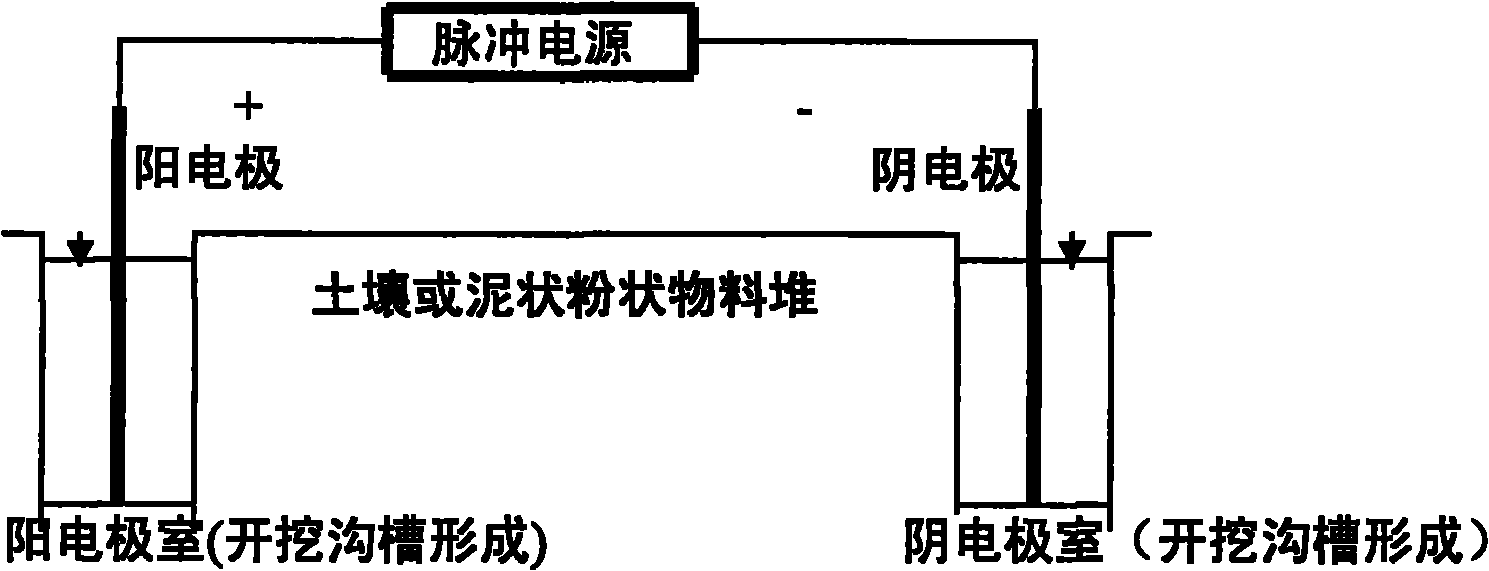Method for removing soluble heavy metal ions in situ
A heavy metal ion, soluble technology, used in the improvement of process efficiency, the restoration of polluted soil and other directions, can solve the problems of low energy consumption and large processing energy consumption, achieve low energy consumption, high efficiency, and overcome the inability to eliminate electrode electrodes. the effect of
- Summary
- Abstract
- Description
- Claims
- Application Information
AI Technical Summary
Problems solved by technology
Method used
Image
Examples
example 1
[0089] Comparison of 120h remediation effect of two methods on copper ion polluted soil
[0090] In order to ensure the accuracy of the comparison experiment, copper ions with a content of 500 mg / kg were specially formulated into the same soil without heavy metal pollution in a uniform wet state to form Cu +2 The test soil sample with a content of 500mg / kg was dried for use, and then under the premise of ensuring that the initial conditions and operation steps were identical except for the different power sources, the pulse electrokinetic method and the direct current electrokinetic method were tested with a long running time of 120h. The efficiency of removing heavy metal ions was compared.
[0091] 1) Power supply operating conditions:
[0092] DC power supply: the voltage gradient is 1.0v / cm; after the first start-up, the initial voltage gradient is maintained and the continuous operation time is 120h (5d).
[0093] Pulse power supply: the input port is the mains input po...
example 2
[0100] Comparison of 120h removal efficiency of heavy metal ions in excess activated sludge by two methods
[0101] Similarly, in order to ensure the accuracy of the comparison experiment, a certain amount of copper ions was prepared in the uniform wet state of the remaining activated sludge after dehydration taken from the same sewage plant to form a test mud sample with a total content of heavy metal ions of 700mg / kg. , and then under the premise of ensuring that the initial conditions are identical except for the different power sources, a comparative experiment was carried out on the removal efficiency of heavy metal ions by the pulse electrokinetic method and the direct current electrokinetic method with a long running time of 120 h.
[0102] 1) Power supply operating conditions:
[0103] DC power supply: the voltage gradient is 1.0v / cm; after the first start-up, the initial voltage gradient is maintained and the continuous operation time is 120h (5d).
[0104] Pulse pow...
comparative experiment example 2
[0189] Removal of soluble heavy metal ions in activated sludge
[0190] The following experiments are a summary of the experimental results of a series of activated sludge samples with different heavy metal contents and different operating conditions.
[0191] The comparative experiments of the two methods running continuously for 24 hours at the same time show that: under the condition that the voltage gradient applied by the DC power supply to the sample is equal to the value of the pulse peak voltage gradient applied by the pulse power supply to the sample under the same original condition, the pulse electrokinetic method has no effect on the sample. The removal efficiency of soluble heavy metal ions in activated sludge is always better than that of direct current electrokinetic removal method. The specific series of examples are: while Cu in activated sludge +2The content range is 0.002%-0.1%, and the setting value range of electric operation parameters is DC power supply...
PUM
 Login to View More
Login to View More Abstract
Description
Claims
Application Information
 Login to View More
Login to View More - R&D
- Intellectual Property
- Life Sciences
- Materials
- Tech Scout
- Unparalleled Data Quality
- Higher Quality Content
- 60% Fewer Hallucinations
Browse by: Latest US Patents, China's latest patents, Technical Efficacy Thesaurus, Application Domain, Technology Topic, Popular Technical Reports.
© 2025 PatSnap. All rights reserved.Legal|Privacy policy|Modern Slavery Act Transparency Statement|Sitemap|About US| Contact US: help@patsnap.com



